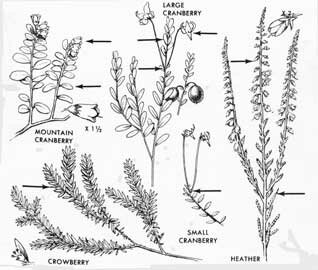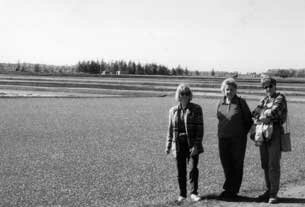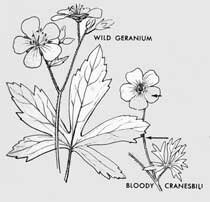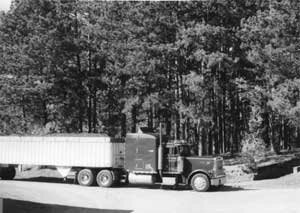
Discover rewarding casino experiences. 
Click on the Flag for More Information |
Yes, as far back as 1672, three hundred plus years ago, the cranberry was being extolled and used as an accompaniment at meals. The native American Ojibways even before that were making a tea from the cranberry leaves as a cure for nausea and probably many more things than that.
It wasn't until the early 1800s, however, that cranberries were actually cultivated for commercial use. Before that the brilliant red berry was merely gathered and sold as a local market crop wherever they were found which, as it turns out, was in many, many places, not just New England as we might have supposed. Some were sent to Europe and the West Indies; then the vines were introduced to England "as plant of easy culture, and with little expense, meadows which are barren wastes might be converted into profitable cranberry fields. Any meadow will answer," was part of the spiel. Cranberries could be found in such widely spread environs as the Eastern seaboard, west across the top of the United States to Minnesota and in Oregon and Washington states beside the Pacific coast. Arkansas and West Virginia and Georgia have cranberries so as you see they are adaptable.
And as we should know, our neighbor Wisconsin argues that it is our nation's largest supplier of the cranberry. Warrens, Wisconsin has an annual cranberry festival but there are many bogs all around that area and near Minocqua too where the accompanying pictures were taken some years ago. The flooded bogs, here a sea of red, are just like the Ocean Spray commercial currently on television. Pictured are Ann Wilson, Thelma Fairbanks and Cara Prowant. The semi is filled with cranberries, not corn! In northern Europe but even with neighborhoods of Scandinavians in the United States, the crowberry or foxberry is sometimes substituted for cranberry and is often called the lingenberry. Yes. Lingenberry pie served at the Red Oak in Bishop Hill, Illinois is memorable! There is a southern cranberry, too, noted for its flavor. How versatile, eh? The cranberry has wiry, creeping stems with small evergreen leaves, oval or elliptical. The flowers of the plant appear in June, they being four-lobed and rose tinted. The American large and small cranberry have recurved "Turk's cap-like" petals, look much like the wildflower Shooting Star or the Night Shade. The illustrations here are from Roger Tory Peterson's Wildflower Guide, the bible of nature lovers. The mountain cranberry however has no such "cap" but a cup-like flower at the end of the stalk with black dots on the underside of the leaves. And by the way, the high-bush cranberry or cranberry tree is not of the same family. It's of the Honeysuckle clan. It's the recurved flower with its pointy stamen that gives it its name ... It looks like a bird's beak ... A crane's beak, the name deriving from Old German, Kranbere, cran-berry. That's not to be confused with crane's bill, another name for the hardy, wild geranium of which there are many specimen, its stamen a "crane's bill" also (see Peterson's example this page). Its petals are not swept back, however. They all are in the Geranium family while the cranberry is of the Heath family.
As with all commercially grown products there are many different kinds of cranberry to suit the landscape (!) such as Early Black, McFarlin, Searls, Beckwith, Stevens, Wilcox, Howes and so forth, they ranging from red to speckled red/white and white which surprises us in the juice it produces. Berries develop through summer from those interesting flowers of spring and are harvested in September and October. They like wet, marshy places and thrive in acidic soils, peaty and vegetable moss with a layer of sand over all. Sand is added every few years. Of course, they don't grow in water, that's the harvesting technique ... They are "mowed" with the berry rising to the water's surface as the recessed "bog" is flooded ... Collection and packaging result in the tart, red fruit we've learned to love as sauce and juice, in salads, breads, etc. Somewhere I've read a cranberry pie recipe but where is not immediate knowledge. There are diseases which attack the cranberry which may be controlled with chemicals ... There's fruit-rot, insects and weeds which may be hand picked or sprayed. Flooding the bogs protects the "fields" from winter injury and frost damage. What the ratio is of cranberry sauce to juice with its many "partnerships" we didn't pursue ... Grape, apple, etc. but we realize what an excellent job the cranberry industry has done in promoting itself and spreading the word of the fruit's many healthful qualities which are sworn to by many. As with the history of everything, the cranberry has much more than at first meets the eye. We've taken it for granted, haven't we, these three hundred plus years?
The following was written in 1966 by Eliot Porter in "Summer Island," a rare appreciation of the cranberry and so much a tradition at Thanksgiving and the holiday season ... "And in peaty soil on headlands above the bay when the air is crisp with a foretaste of fall, one finds the slow-ripening highland cranberries that can be cooked into a more tangy, tart, delicious sauce than the Cape Cod cranberry has ever made. Intermingling with the heathery crowberry, the cranberry bushes form a closely woven, spring mat, which smooths over all the lesser irregularities of the rough ground. Upon arriving at such a place, the picker is tempted to forget the berries, to stretch out in the heathy, sour fragrance and the relaxing warmth of the Sun, and give up all purposes, surrendering to the indulgence of his senses. Who says that to dream away an afternoon with a foam-streaked bay spread out before your half-shut eyes and a wind stroking your face is not as purifying as gathering a small basket of bullet-hard berries for cranberry jelly?"
|







